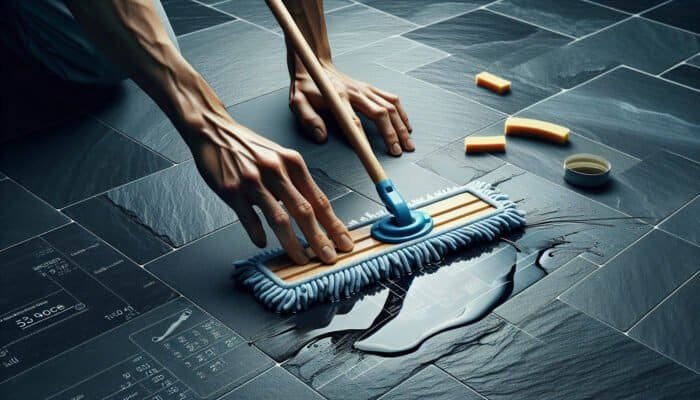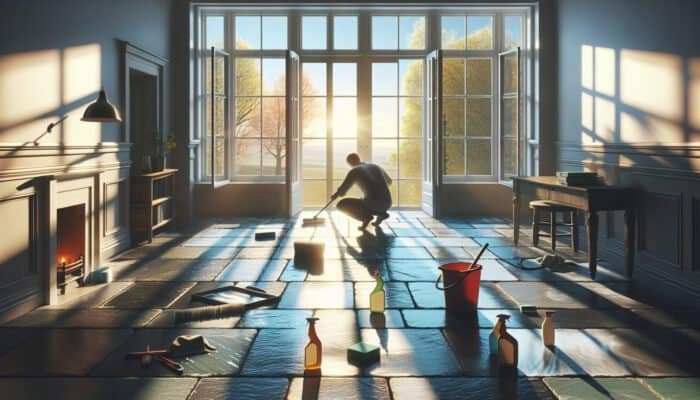
Why You Should Clean Your Slate Floors
Last Updated on June 1, 2025 by David
Cleaning And Maintaining Slate Floors for Long-Lasting Beauty
Why You Should Clean Your Slate Floors is more than just an aesthetic concern; it’s essential for protecting and maintaining its beauty, longevity, and functionality. Slate floors require proactive protection and maintenance to preserve their beauty, longevity, and functionality. To begin with, daily maintenance is crucial in maintaining the integrity of your slate floors. This involves sweeping or vacuuming the floor regularly to remove dirt and debris that can scratch the surface. Mopping with a microfibre mop, a gentle slate cleaner, and warm water is also essential to keeping the floor clean and free of stains. Use a cleaning solution specifically designed for natural stone floors, as harsh chemicals can damage the slate. Additionally, dry the floor thoroughly after mopping to prevent water spots from forming.
Beyond daily maintenance, it’s important to perform deeper cleaning and maintenance tasks on a regular basis. This includes resealing the floor every 1-2 years, depending on the level of foot traffic and wear. Resealing provides an extra layer of protection against stains and damage, and helps to maintain the floor’s original appearance. It’s also recommended to perform a deep clean on the floor every 2-3 months, using a gentle scrubbing agent and warm water to remove any built-up dirt and grime. This can be done using a soft-bristled brush or a scrubbing pad specifically designed for natural stone floors. By following these essential steps, homeowners can ensure their slate floors remain beautiful, functional, and long-lasting for years to come.
Key Takeaways For Why You Should Clean Your Slate Floors

• Regular cleaning and maintenance prevent damage and discolouration, ensuring slate floors remain beautiful and functional.
• Daily sweeping and mopping, along with gentle cleaning products, safeguard against scratches and stains.
• Scheduling regular cleaning routines, including seasonal deep cleaning and resealing, maintains the floor’s integrity.
• Applying a sealer or wax provides an extra layer of protection against spills and stains, preserving the slate’s appearance.
• Avoiding harsh chemicals and abrasive materials prevents damage, ensuring the longevity and safety of slate floors.
To clean slate floors, what should you use?
A vacuum cleaner or soft brush, microfiber mop and water-based cleaning solution are the best ways to clean slate floors.
You can use many different tools to clean your floor. You need to know which one will work best for you.
The table below, examines some of the most popular tools on the market today.
- A HEPA filter dry vacuum cleaner, soft brush or a microfiber dry mop will remove dry soils.
When you use a vacuum cleaner, make sure to use a soft brush attachment to protect the slate.
A hard brush attachment can scratch the slate. - A damp microfiber mop is best to damp wipe the floor.
If you suffer from back issues or arthritis, a microfiber flat mop may be easier for you to use. - You should mop the floor with a slate floor cleaning solution because it will remove the soil residues and will not damage the slate or the existing sealer.
Pro Tip: If your slate floor has an acrylic topical sealer like LTP Ironwax, use the manufacturer’s recommended cleaner as it contains ingredients that reinforce the sealer, helping to increase its life.
How often should you sweep and damp-mop slate floors?
Maintaining slate floors requires regular sweeping and mopping.
To keep your slate floors looking great, it is important to know how often to sweep and damp mop them.
When it comes to damp mopping and sweeping slate floors, there are some things you should remember.
- You should clean your slate floors at least 2 times a week.
If you have a heavy traffic area, pets or children, you should increase the frequency to avoid a buildup of soils. - Before you damp mop, always remove dry soil by sweeping or vacuuming with a HEPA vacuum cleaner.
A microfiber damp mop will remove more soil than an old-style cotton mop. - It is crucial that pet owners are diligent and clean up after their pets.
Which time of the year is best to clean slate floors?

Weekly cleaning should take place throughout the year. If you need to deep clean your floor and reseal your floor then try to avoid the winter months. Slate restoration is best undertaken in the spring or summer when the weather is warmer as you will need to have your windows open to help the floor dry after cleaning and sealing.
The Importance of Sealing
Slate floors require sealing to protect the stone from stains, spills, and wear, thereby maintaining its natural beauty and extending its lifespan. Sealing safeguards the slate from damage, making it easier to clean and maintain. Sealer options are available to suit individual preferences, including impregnating sealers for a natural, matte finish, and topical urethane or acrylic sealers for a sacrificial wear layer and a sheen or gloss finish. Regular sealing is essential to preserve the slate’s appearance and longevity. By choosing the right sealer, homeowners can enjoy the benefits of a protected slate floor that remains beautiful and functional. With the right sealer, slate floors can maintain their elegance and sophistication, providing a sense of freedom and relaxation in any living space.
How do you keep your slate patio clean?
If you want to keep your patio clean, sweep it regularly to remove dry soil and plant material. Decomposing soil and plants release chemicals that can stain your patio. At least once per week sweep and wash down your patio with clean water. If there are difficult marks, use a slate-friendly cleaner to remove the marks. Check the sealer and reseal any areas that are showing signs of sealer wear.
What product is best for a slate patio?

You can use a lot of different things on your slate patio. There are a lot of different types of sealer available. Make sure to use a sealer that is made for use outdoors. Outdoor sealers contain ingredients to minimise damage from ultraviolet light. Outdoor slate sealers should be anti-slip to prevent accidents Don’t be tempted to use traditional paint to protect your patio. Paints will discolour the slater, covering the natural beauty of the stone. Removing paints is difficult and messy.
The Importance of Sealing
Slate floors require sealing to protect the stone from stains, spills, and wear, thereby maintaining its natural beauty and extending its lifespan. Sealing safeguards the slate from damage, making it easier to clean and maintain. Sealer options are available to suit individual preferences, including impregnating sealers for a natural, matte finish, and topical urethane or acrylic sealers for a sacrificial wear layer and a sheen or gloss finish. Regular sealing is essential to preserve the slate’s appearance and longevity. By choosing the right sealer, homeowners can enjoy the benefits of a protected slate floor that remains beautiful and functional. With the right sealer, slate floors can maintain their elegance and sophistication, providing a sense of freedom and relaxation in any living space.
Frequently Asked Questions
Can I Use a Steam Cleaner on My Slate Floors?
Did you know that 80% of slate floor damage is attributed to improper cleaning methods? Whilst steam is a fantastic cleaner, there are too many risks when using it for maintenance cleaning slate floors, the main ones being.
If the steam is too hot you will destabilise the sealer.
If you over-wet the cleaning head, the cleaning will be less efficient.
If you add a chemical to the steamer, the heat may can make it more aggressive.
Steam cleaning can be useful for restoration cleaning, when a new coat of protection will be applied after cleaning.
How Do I Remove Stubborn Stains From My Slate Floors?
To remove stubborn stains from slate floors, identify the stain type and apply a targeted cleaning solution. Prevent future stains by sealing the floor, using place mats, and promptly cleaning spills, ensuring a stain-free and well-maintained slate surface.
Are All Slate Floor Sealers Suitable for High-Traffic Areas?
Slate is fine for high traffic areas, however expect to see wear as slate is a relatively soft material. The key to longevity is using an appropriate sealer or the installation, regular cleaning and maintaining the level of protection.
Can I Use a Mop With a Scrubbing Strip on My Slate Floors?
Avoid using a mop with a scrubbing strip on your slate floors, as it can scratch the surface. Instead, opt for a soft, microfiber mop and clean the floor after proper preparation, ensuring a safe and effective cleaning process.
How Often Should I Reapply a Topical Sealer to My Slate Floors?
For maximum protection, reapply topical sealers to your slate floors every 6-12 months, depending on foot traffic and wear. Impregnating sealers may require less frequent reapplication, while urethane or acrylic sealers need more frequent touch-ups for sustained protection and shine.
9 Hazel Avenue
Lenzie
Glasgow
G66 4RR
07533-873-476
Copyright © Repair Restore Revive - Abbey Floor Care.
We are proud to be your local stone floor cleaning, polishing, and restoration specialists for homes and commercial properties in Central Scotland.
With years of experience working with all types of stone floors, our friendly and professional stone floor cleaning services can’t be beaten on price or service.